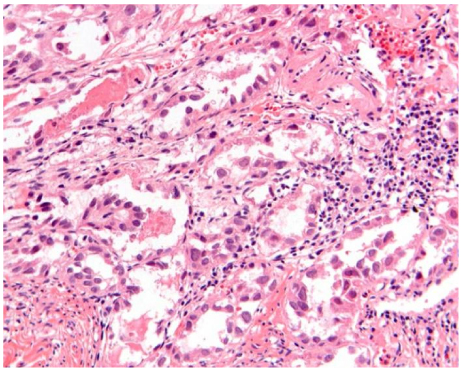Korean J Obstet Gynecol.
2010 Apr;53(4):371-376. 10.5468/kjog.2010.53.4.371.
A case of clear cell carcinoma of uterine cervix not related to intrauterine dietylstilbesterol exposure
- Affiliations
-
- 1Department of Obstetrics and Gynecology, Dongguk University Ilsan Hospital, Goyang, Korea. rohjuwon@dumc.or.kr
- 2Department of Pathology, Dongguk University Ilsan Hospital, Goyang, Korea.
- KMID: 2273866
- DOI: http://doi.org/10.5468/kjog.2010.53.4.371
Abstract
- Clear cell carcinoma of the uterine cervix is rare cancer that accounts for 4 to 9% of the adenocarcinoma of uterine cervix. Although intrauterine exposure to diethylstilbestrol (DES) during early pregnancy is one of the established risk factors, DES exposure may not be confirmed in all patients. We experienced a case of clear cell carcinoma in the uterine cervix of 67-year-old woman who was not exposed to DES. She was initially diagnosed as endometrial clear cell carcinoma because of the normal colposcopic finding and histologically proven clear cell carcinoma from endometrial aspiration biopsy and endocervical curettage. We performed a total laparoscopic hysterectomy with bilateral salpingo-oophorectomy and lymphadnectomy including both pelvic and para-aortic regions. On the final pathologic diagnosis of clear cell carcinoma confined to endocervix, the patient was received adjuvant concurrent chemoradiation with weekly cisplatin. We present the case with a brief review of related literature.
MeSH Terms
Figure
Reference
-
1. Tavassoli FA, Devilee P, editors. World Health Organization: tumours of the breast and female genital organs. 2003. Lyon: IARC press;297–301.2. Scully RE, Barlow JF. "Mesonephroma" of ovary. Tumor of Müllerian nature related to the endometrioid carcinoma. Cancer. 1967. 20:1405–1417.
Article3. Herbst AL, Ulfelder H, Poskanzer DC. Adenocarcinoma of the vagina. Association of maternal stilbestrol therapy with tumor appearance in young women. N Engl J Med. 1971. 284:878–881.
Article4. Hanselaar A, van Loosbroek M, Schuurbiers O, Helmerhorst T, Bulten J, Bernhelm J. Clear cell adenocarcinoma of the vagina and cervix. An update of the central Netherlands registry showing twin age incidence peaks. Cancer. 1997. 79:2229–2236.10. Smith HO, Tiffany MF, Qualls CR, Key CR. The rising incidence of adenocarcinoma relative to squamous cell carcinoma of the uterine cervix in the United States: a 24-year population-based study. Gynecol Oncol. 2000. 78:97–105.11. Goto K, Takeuchi Y, Yakihara A, Kotsuji F. Synchronous invasive squamous cell carcinoma and clear cell adenocarcinoma of the uterine cervix: a different human papillomavirus status. Gynecol Oncol. 2005. 97:976–979.
Article12. Pirog EC, Kleter B, Olgac S, Bobkiewicz P, Lindeman J, Quint WG, et al. Prevalence of human papillomavirus DNA in different histological subtypes of cervical adenocarcinoma. Am J Pathol. 2000. 157:1055–1062.
Article13. Reich O, Tamussino K, Lahousen M, Pickel H, Haas J, Winter R. Clear cell carcinoma of the uterine cervix: pathology and prognosis in surgically treated stage IB-IIB disease in women not exposed in utero to diethylstilbestrol. Gynecol Oncol. 2000. 76:331–335.
Article14. Boyd J, Takahashi H, Waggoner SE, Jones LA, Hajek RA, Wharton JT, et al. Molecular genetic analysis of clear cell adenocarcinomas of the vagina and cervix associated and unassociated with diethylstilbestrol exposure in utero. Cancer. 1996. 77:507–513.
Article15. Waggoner SE, Baunoch DA, Anderson SA, Leigh F, Zagaja VG. Bcl-2 protein expression associated with resistance to apoptosis in clear cell adenocarcinomas of the vagina and cervix expressing wild-type p53. Ann Surg Oncol. 1998. 5:544–547.
Article16. Herbst AL. Diethylstilbestrol and adenocarcinoma of the vagina. Am J Obstet Gynecol. 1999. 181:1576–1578.
Article17. Okamoto Y, Hirota S, Soejima T, Maeda H, Takada Y, Hasegawa K, et al. Radiotherapy for adenocarcinoma of the uterine cervix. Nippon Igaku Hoshasen Gakkai Zasshi. 1997. 57:936–941.18. Thomas MB, Wright JD, Leiser AL, Chi DS, Mutch DG, Podratz KC, et al. Clear cell carcinoma of the cervix: a multi-institutional review in the post-DES era. Gynecol Oncol. 2008. 109:335–339.
Article19. Stehman FB, Rose PG, Greer BE, Roy M, Plante M, Penalver M, et al. Innovations in the treatment of invasive cervical cancer. Cancer. 2003. 98:2052–2063.
Article20. Kwack HS, Mun YJ, Ha JE, Hwang SJ, Kim SM, Han KT, et al. Fertility-sparing radical abdominal trachelectomy for cervical clear cell adenocarcinoma unrelated to diethylstilbestrol exposure: a case report. Korean J Obstet Gynecol. 2009. 52:960–965.
- Full Text Links
- Actions
-
Cited
- CITED
-
- Close
- Share
- Similar articles
-
- A case of clear cell carcinoma that is unrelated to diethystilbestrol of the uterine cervix
- A Case of Clear Cell Adenocarcinoma in the Uterine Cervix of 22 Years-Old Virgin
- A Case of Clear Cell Adenocarcinoma of the Cervix Uteri and it's Diethylstillbestrol - related Maternal History
- Clear Cell Adenocarcinoma of the Uterine Cervix in a 15-Year-Old Girl: A Case Report
- A case of clear cell adenocarcinoma in the uterine cervix of 52-year-old virgin



